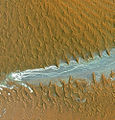Namib Desert

The Namib Desert is a desert in Namibia and southwest Angola that forms part of the Namib-Naukluft National Park. The name "Namib" is of Nama origin and means vast.
The desert occupies an area of around 80 900 km²[1] (31 200 square miles), stretching about 1000 miles (1,600 km) along the Atlantic Ocean coast of Namibia. Its east-west width varies from 30 to 100 miles (50-160 km). The Namib Desert also reaches into southwest Angola. It is one of the 500 distinct physiographic provinces of the South African Platform physiographic division.
Having endured arid or semi-arid conditions for at least 55 million years[2], it is considered to be the oldest desert in the world. The Namib's aridity is caused by the descent of dry air of the Hadley Cell, cooled by the cold Benguela current along the coast. It has less than 10 mm (0.4 inches) of rain annually and is almost completely barren.
A number of unusual species of plants and animals are found only in this desert. One of these is Welwitschia mirabilis, one of the most unusual species. Welwitschia is a shrub-like plant, but grows just two long strap-shaped leaves continuously throughout its lifetime. These leaves may be several meters long, gnarled and twisted from the desert winds. The taproot of the plant develops into a flat, concave disc in age. Welwitschia is notable for its survival in the extremely arid conditions in the Namib, sometimes deriving moisture from the coastal sea fogs.
Although the desert is largely unpopulated and inaccessible, there are year-round settlements at Sesriem, close to the famous Sossusvlei and a huge group of sand dunes, which at more than 300 meters high are among the tallest sand dunes in the world. The complexity and regularity of dune patterns in its dune sea have attracted the attention of geologists for decades. They still remain poorly understood.

The interaction between the water-laden air coming from the sea via southerly winds, some of the strongest of any coastal desert, and the dry air of the desert causes immense fogs and strong currents, causing sailors to lose their way. Along with the Skeleton Coast further north, it is notorious as the site of many shipwrecks. Some of these wrecked ships can be found as much as 50 metres inland, as the desert slowly moves westwards into the sea, reclaiming land over a period of many years.
The Namib desert is an important location for the mining of tungsten, salt and diamonds. As documented in some extraordinary detail in the BBC Planet Earth (TV series) episode #5 on deserts, there is a struggle for existence in this desert by elephants, lions, oryx and other valiant survivors, a struggle that is surprising in that anything can find sustenance here at all. (A pair of oryx is seen on the Namibian coat of arms.)
Access is by light aircraft from Windhoek (the capital of Namibia, about 480 km north-east of the centre of the desert), Swakopmund and Walvis Bay at the north end of the desert, or overland on gravel roads.
Gallery
|
Camel Thorn Tree (Acacia erioloba) in Sossusvlei region |
 The dune sea of the Namib Desert. The crests of the dunes are aligned in a marked northwest-southeast orientation. The dunes act as obstacles, causing the winds to be deflected significantly to the right, in effect reorienting the southerly wind to become a southwesterly wind. |
 Sunset at the Namib Rand Nature Reserve, Namibia. |
 Satellite image of the Namib Desert. |
 Namib Desert seen from Spot satellite |
 Namib Desert seen from Spot satellite |
See also
- Bogenfels
- List of deserts by area
- Animals are Beautiful People, a nature documentary set in the Namib
References
- ↑ http://www.nationalgeographic.com/wildworld/profiles/terrestrial/at/at1315.html World Wildlife Fund and National Geographic info sheet
- ↑ Namib desert (AT1315) World Wide Fund for Nature site on the Namib Desert
- National Geographic, January 1992, pp. 54-85.
- "Dune Patterns, Namib Desert, Namibia". NASA Earth Observatory. http://earthobservatory.nasa.gov/Newsroom/NewImages/images.php3?img_id=17050. Retrieved 2006-05-05.
- Namib Naukluft Park photo gallery
- Namib Desert photo gallery
- Mary Seely: The Namib: Natural History of an Ancient Desert, 3rd ed., Windhoek: Desert Research Foundation of Namibia 2004, ISBN 99916-68-16-0.
|
|||||||||||||||||||||||||
|
|||||||
|
|||||||||||||||||||||||||||||
